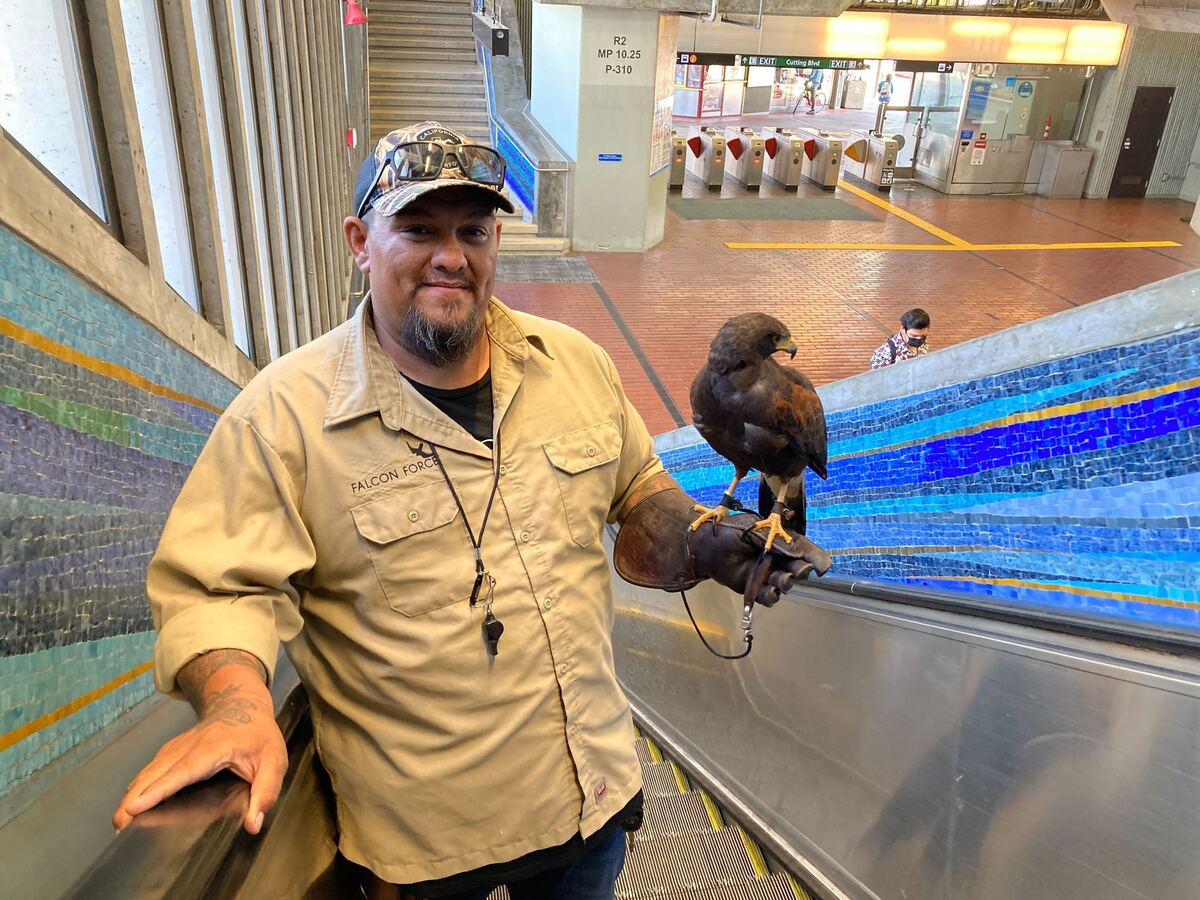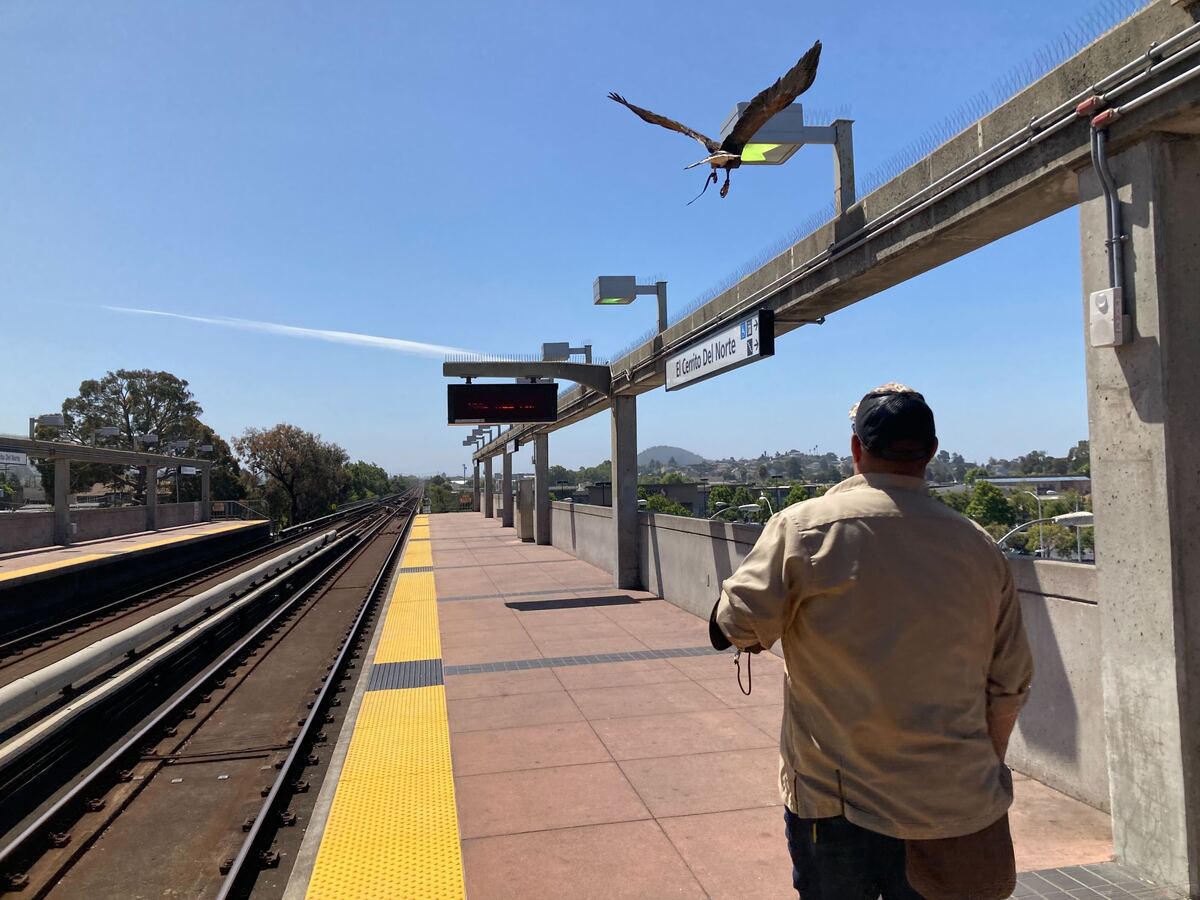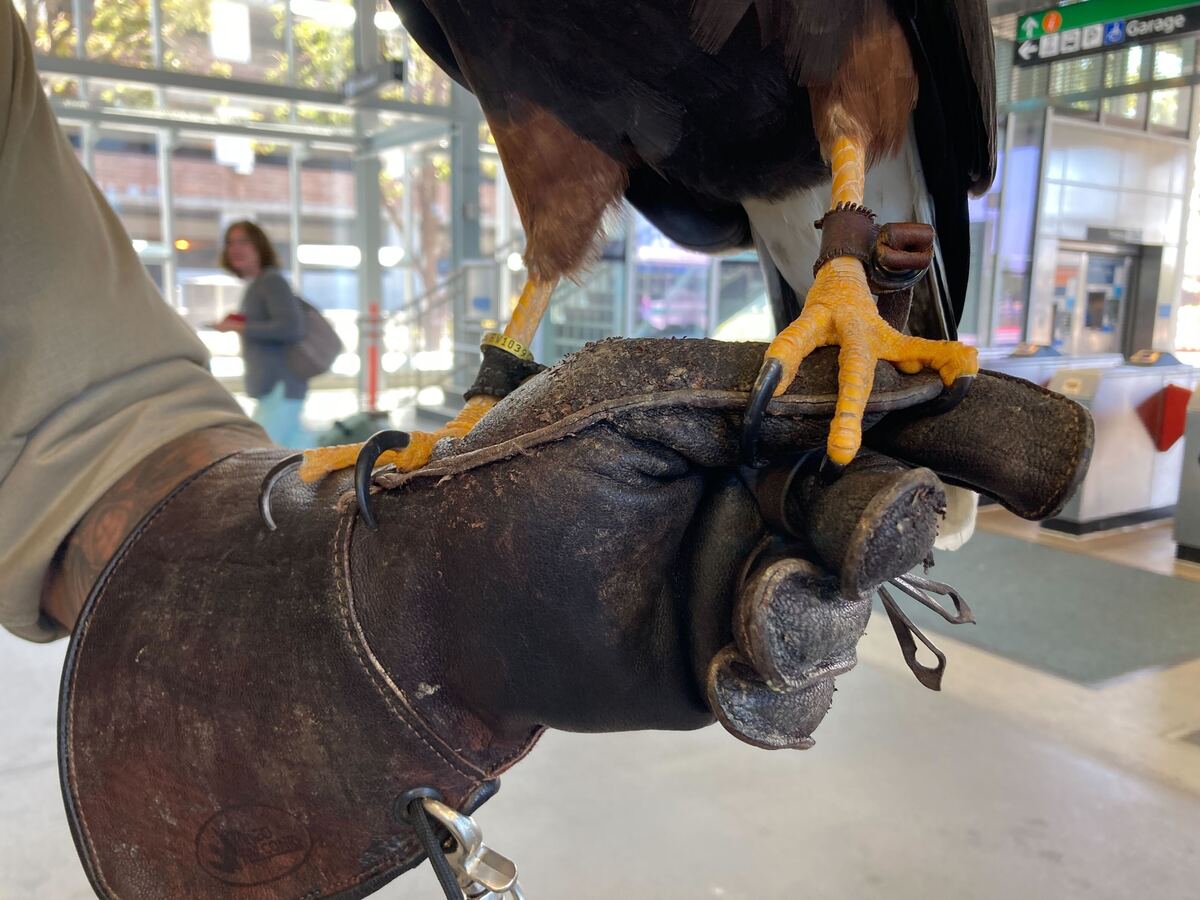Pac-Man the hawk is solving a California BART station’s pigeon problem : NPR

Falcolner Ricky Ortiz poses with Pac-Man, a Harris’s hawk, at the El Cerrito del Norte BART station in El Cerrito, Calif.
Raquel Maria Dillon/NPR
hide caption
toggle caption
Raquel Maria Dillon/NPR

Falcolner Ricky Ortiz poses with Pac-Man, a Harris’s hawk, at the El Cerrito del Norte BART station in El Cerrito, Calif.
Raquel Maria Dillon/NPR
A light rail station in the California Bay Area has turned to an unlikely hero to try to solve its pigeon problem: Pac-Man.
No, not the perpetually hungry video game character. This Pac-Man is a roughly 6-year-old, 1.5-pound, quail-loving Harris’s hawk, a uniquely social bird of prey native to the American Southwest.
He and his handler work for a pest abatement company called Falcon Force, which BART hired in late May to help scatter pesky pigeons away from its station in the San Francisco suburb of El Cerrito del Norte.
“Pretty much wherever you could perch, there was a pigeon,” falconer Ricky Ortiz says of the scene when the duo first got started.
Like many other public transit hubs, the station’s oasis of nesting ledges, signs, platforms and piping conduits makes it a perfect environment for pigeons to thrive, explains Falcon Force owner Vahe Alaverdian. And they can raise up to six clutches (with two babies each) per year, which adds up fast.
It’s not just that the pigeons and their droppings are an eyesore — they’re also health hazards, since they could be carrying bacteria or parasites.
BART says it has tried plenty of pigeon-removal tactics over the years, from installing bird-repellent spikes and netting to bringing in owl statues and experimenting with noise. BART spokesperson Chris Filippi explains that the station set out to explore yet another option in response to concerns raised by riders, many of whom were returning to trains for the first time since the pandemic.
And so far, Pac-Man appears to be acing the challenge with flying colors. The three eight-hour days that he and Ortiz spend at the largely open-air station each week have already made a noticeable difference.
Ortiz says after the first week or so he saw about half as many pigeons, and at this point, he and Pac-Man are mostly just making the rounds to deal with the few that still “like to come in and out.”
“What we have here is a really new approach that’s only been around for a couple of months now, and it’s been highly effective,” Filippi says. “We’re really impressed with the impact it’s having.”

Pac-Man flies above one of the station’s platforms. It doesn’t take much work for him to disperse loitering pigeons, though he does sometimes chase them.
Raquel Maria Dillon/NPR
hide caption
toggle caption
Raquel Maria Dillon/NPR

Pac-Man flies above one of the station’s platforms. It doesn’t take much work for him to disperse loitering pigeons, though he does sometimes chase them.
Raquel Maria Dillon/NPR
The name of the game is startling pigeons
So what exactly is Pac-Man doing, if not gobbling up row after row of pigeons?
The raptor’s job is to prevent pigeons from nesting in that particular area — and because of nature’s predator-prey relationship, that doesn’t take much work.
Ortiz explains that because pigeons are innately fearful when they sense predators nearby, Pac-Man’s mere presence is enough to scare them away in most cases. But he does sometimes chase after them, in which case “they learn really quick that it’s not a safe place to hang out.”
“It just becomes a hostile environment for the pigeons to exist there, coexist there, with a native hawk,” Alaverdian says. “So they just basically go across the street into the other parking lot and find the docks and so on to continue life … without getting harmed.”
Alaverdian, a master falconer who’s been in the business for years, explains that incidents do sometimes happen in this line of work. After all, a predator won’t be motivated to chase a species if it knows it won’t be able to eat its catch. But Falcon Force trains its birds to come back at the call of a whistle, in exchange for a tidbit of something like quail or rabbit.
This way, the falcons won’t come into direct contact with potentially disease-borne pigeons, and the pests — who are considered an invasive species and not regulated — can live to see another day.

Pac-Man and Ortiz work for a pest abatement company called Falcon Force, whose clients range from agricultural growers to industrial sites.
Raquel Maria Dillon/NPR
hide caption
toggle caption
Raquel Maria Dillon/NPR

Pac-Man and Ortiz work for a pest abatement company called Falcon Force, whose clients range from agricultural growers to industrial sites.
Raquel Maria Dillon/NPR
Not all hawks are qualified for the job
Pac-Man wears a GPS transmitter in case he wanders off, as required by state law, but Ortiz says he’s never had to use it. That came as a bit of surprise, since he had expected Pac-Man might initially be a little thrown off by the sounds of trains coming and going.
Instead, Ortiz says, he was “real steady right off the bat.”
Both he and Alaverdian attribute that to the nature of his species. Harris’s hawks are the only social species of raptor, hunting and feeding together akin to wolves. That makes them great birds for this type of task.
“Because of their social nature, they are the perfect and most adaptable species to take on this kind of relationship that we have with these birds — in tight places, in public, with noises [and] trains coming and going and so on and so forth,” Alaverdian adds.
And it’s not just that they’re not easily phased by their environment. Ortiz also believes that the species’ social nature makes for better relationships with their handlers.
“Some birds are kind of just aloof, but I haven’t met a Harris’s hawk yet that hasn’t had some kind of bond with their falconer,” he says.
Different species have different strengths, and Alaverdian says he acquires a lot of his birds secondhand as retired or dismissed falconry birds who didn’t exactly suit their owners’ needs. That was the case for Pac-Man, who was originally obtained by another falconer to hunt jackrabbits but wasn’t equipped for the job because of his relatively small size.
So Pac-Man arrived at Falcon Force having been calmed down in captivity already, and designated a perfect bird to intimidate smaller avians. Alaverdian says that also means he’s not interested in anything on the ground — so Chihuahua-toting BART riders don’t need to worry (though owners, be warned: dogs freak Pac-Man out, so he might scream at them).

Tim Gibson, a self-described lover of birds and sharks, stops by to admire Pac-Man and chat with Ortiz.
Raquel Maria Dillon/NPR
hide caption
toggle caption
Raquel Maria Dillon/NPR

Tim Gibson, a self-described lover of birds and sharks, stops by to admire Pac-Man and chat with Ortiz.
Raquel Maria Dillon/NPR
Pac-Man is becoming a household name
But commuters aren’t exactly concerned about Pac-Man. In fact, as Ortiz puts it, he’s become something of a local celebrity.
“A lot of people are excited because they don’t get to see a bird of prey up close,” he says. “They’re usually pretty interested and have the usual questions.”
Most people just want to get as close as they can and take a good look at the bird. But some fans are especially devoted.
Ortiz says he saw one person skip three consecutive trains in order to check Pac-Man out, and another made the trip all the way from the Monterrey area just to see him.
While Ortiz was chatting with NPR, a man came over to see whether the bird he had spotted on the platform was in fact a Harris’s hawk. Tim Gibson explained that he loves birds and uses binoculars to study them in the wild.
“Beautiful, beautiful bird,” he said. “I’m sorry to bother you guys, I just had to see him.”
Gibson has noticed the area’s pigeon problem, and thinks this is a promising solution. He adds: “We just have to stay out of the way.”
This audio for this story was produced by Ben Abrams and edited by Raquel Maria Dillon.






